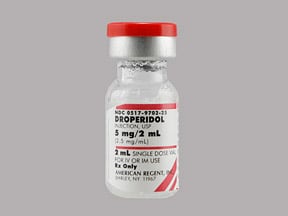
Droperidol Coupons & Savings Card – Discount Prices from $1.01
My prescription
Edit
1ML of 2.5MG/ML, Droperidol (1 Vial)
Select pharmacy

CVS
$23.55
COUPON PRICE
Walmart
$1.01
COUPON PRICE
Albertsons
$8.55
COUPON PRICE
Walgreens
$8.55
COUPON PRICEDroperidol savings card
Show this card to your pharmacist
Walmart
$1.01
BIN
ID
PCN
GRP
019876
LH444E4091
CHIPPO
LHX
Powered by
Related dopamine receptor antagonists prescriptions
More prescriptions for nausea
Related dopamine receptor antagonists prescriptions
More prescriptions for nausea
Droperidol dosage forms
Dosage Quantity Price from Per unit 1ML of 2.5MG/ML 1 Vial $1.01 $1.01 1ML of 2.5MG/ML 2 Vials $5.21 $2.60 1ML of 2.5MG/ML 3 Vials $10.32 $3.44
| Dosage | Quantity | Price from | Per unit |
|---|---|---|---|
| 1ML of 2.5MG/ML | 1 Vial | $1.01 | $1.01 |
| 1ML of 2.5MG/ML | 2 Vials | $5.21 | $2.60 |
| 1ML of 2.5MG/ML | 3 Vials | $10.32 | $3.44 |
Droperidol Warnings
Please review the following safety information and warnings regarding the use of this medication to ensure its safe and effective use. If you have any concerns, consult with your healthcare provider.
Life-threatening Heart Rhythm Issues (QT Prolongation): Droperidol may cause QT prolongation, a potentially life-threatening alteration in heart rhythm. To mitigate this risk, your healthcare provider will monitor your heart rhythm using an electrocardiogram (EKG) before and after your procedure for 2-3 hours. Inform your provider about all medications you're currently taking and refrain from starting any new ones without prior consultation. Avoid droperidol if you have a history of QT prolongation or arrhythmias. Seek immediate medical attention by calling 911 if you experience pounding chest, difficulty breathing, chest pain, or lightheadedness. Factors increasing risk include electrolyte imbalances, concurrent use of other QT-prolonging drugs, pre-existing heart conditions, and slow heart rate.
Uncontrolled Body Movements: Similar medications have led to involuntary movements like eye twitching or lip-smacking. If you notice such symptoms after receiving droperidol, contact your provider for management options, possibly including anticholinergic medications.
Blood Pressure Changes and Fall Risk: Droperidol may cause fatigue, lower blood pressure, or balance issues, increasing the likelihood of falls post-procedure. Rise slowly from sitting or lying positions, using support for stability. Risk factors include low blood pressure, concurrent use of blood pressure-lowering medications, pre-existing conditions causing low blood pressure, high doses of droperidol, liver or kidney issues, and being aged 65 or older.
Neuroleptic Malignant Syndrome (NMS): Droperidol may lead to NMS, a rare but critical condition marked by fever, sweating, muscle stiffness, confusion, unawareness, and rapid or irregular heartbeat. Since recognizing NMS during a procedure may be challenging, your provider will monitor your temperature, heart rate, and carbon dioxide levels closely. The risk is heightened when taking antipsychotic medications.
Contraindications:
- Do not use droperidol if you have known or suspected QT prolongation.
- Avoid using droperidol for conditions other than nausea and vomiting from procedures when other treatments are unsuitable or ineffective.
If any of these warnings or contraindications apply to you, it is crucial to discuss them with your healthcare provider prior to using this medication.
Droperidol Side Effects
Common side effects:
- Low blood pressure
- Fast heart rate
- Sleepiness after the procedure
- Feelings of unease
- Restlessness
- Anxiety
Less common but important to monitor:
- Dizziness
- Chills
- Shivering
- Uncontrollable, repetitive movements
- Hallucinations
- Allergic reactions
Serious side effects:
- Abnormal heart rhythm
- Serious allergic reaction
- Neuroleptic malignant syndrome (nms)
Droperidol Interactions
When taking droperidol, it's important to be aware of potential interactions with other medications, as these can affect your heart rhythm and central nervous system (CNS). Droperidol can prolong the QT interval on an electrocardiogram (ECG), which measures the heart's electrical activity. This prolongation can increase the risk of a serious heart rhythm disorder called torsades de pointes.
Medications That May Prolong the QT Interval:
Combining droperidol with other drugs that also prolong the QT interval can further increase the risk of heart rhythm problems. Such medications include:
Certain Antiarrhythmics: Medications used to treat irregular heartbeats, such as class I and III antiarrhythmics.
Some Antidepressants: Certain antidepressants have been associated with QT prolongation.
Specific Antihistamines: Some antihistamines can affect heart rhythm.
Antimalarial Drugs: Medications used to prevent or treat malaria.
Calcium Channel Blockers: Drugs that relax blood vessels and increase the supply of blood and oxygen to the heart.
Other Neuroleptics: Medications similar to droperidol used to treat psychiatric conditions.
It's crucial to inform your healthcare provider about all medications you're taking to assess the risk of QT prolongation.
Medications That May Lower Potassium or Magnesium Levels:
Low levels of potassium or magnesium in the blood can also increase the risk of QT prolongation. Medications that can cause these electrolyte imbalances include:
Diuretics: Often referred to as "water pills," these medications help remove excess fluid from the body but can also deplete potassium and magnesium.
Laxatives: Overuse of laxatives can lead to electrolyte imbalances.
Certain Steroids: High doses of steroids with mineralocorticoid activity can affect electrolyte levels.
If you're using any of these medications, your doctor may monitor your electrolyte levels and adjust your treatment plan accordingly.
Central Nervous System Depressants:
Droperidol can enhance the sedative effects of other CNS depressants, leading to increased drowsiness or respiratory depression. These include:
Opioids: Pain-relieving medications.
Barbiturates: A class of sedative drugs.
Tranquilizers: Medications used to reduce tension or anxiety.
General Anesthetics: Drugs used during surgeries to induce unconsciousness.
If you're taking any CNS depressants, your healthcare provider may adjust the dosages to prevent excessive sedation.
Other Considerations:
Epinephrine: Using epinephrine to treat low blood pressure caused by droperidol can paradoxically worsen the condition due to droperidol's effects on blood vessels.
Parkinson's Disease Medications: Droperidol may reduce the effectiveness of medications used to treat Parkinson's disease, such as Levodopa.
Always provide your healthcare provider with a complete list of all medications, supplements, and over-the-counter drugs you're taking. This information is essential to avoid potential interactions and ensure your treatment is safe and effective.
